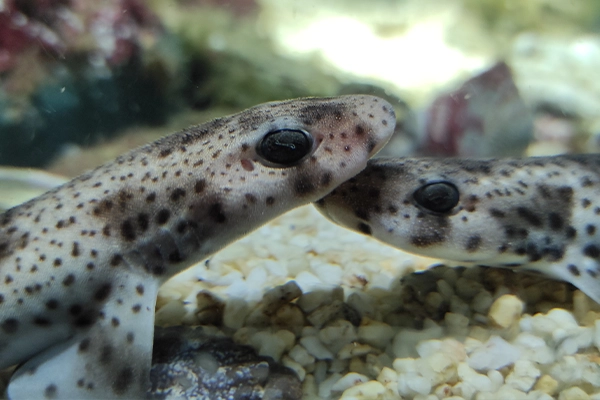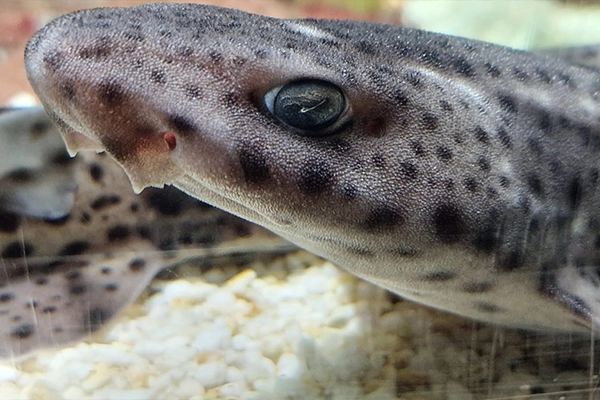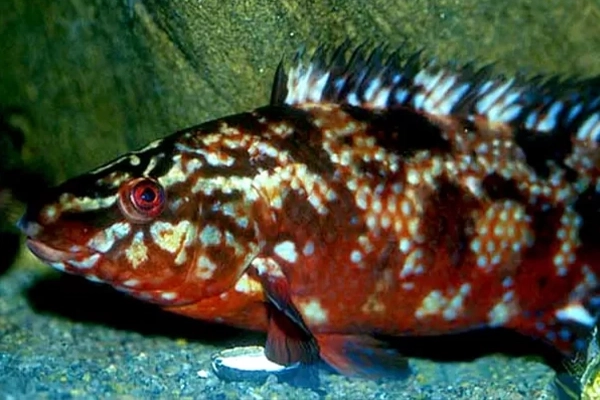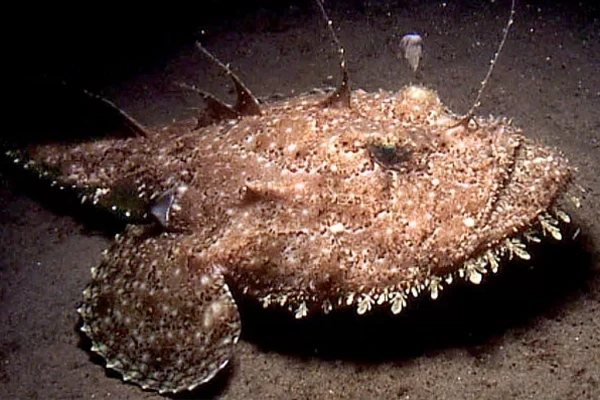

Lesser spotted Catshark
Catsúileach Ballach
The lesser spotted catshark is a native shark species found around the Irish coastline. Sometimes called dogfish they are members of the Catshark family and are opportunistic, nocturnal hunters, feeding on small fish and crustaceans along the seafloor.
Latin
Scyliorhinus Canicula

nursehound
Fíogach Mór
The Nursehound also known as the Greater Spotted Catshark, Large Spotted Dogfish or Bull Huss is another shark species found around Ireland and is a larger cousin to the lesser spotted catshark as it can grow to an average of 1.6 metres. Another nocturnal hunter they usually rest during the day and hunt at night.
Latin
Scyliorhinus Stellaris

Pollock
Mangach
Pollock are an important commercial fish species and are often used as a substitute for more expensive fish such as Cod. They can be found around coastal regions where their dark, golden brown skin camouflages them within seaweed and rock formations. A versatile fish they can be identified by their “S” shaped lateral line, lack of chin barb and lighter colour compared with their cousins, the Coalfish and Cod.
Latin
Pollachius Pollachius

Thick lipped Grey Mullet
Lannach Glas
Commonly found close to shallow coastal waters the thick lipped grey mullet is an important food fish in various parts of the world. It has a wide range and can be found from Iceland to Senegal. Thick lipped grey mullet is known to frequent harbours and sewer outlets and can thrive in brackish water. They are known to be tenacious game fish for many anglers and can grow to an average size of 32cm with the maximum recorded size being 75cm.
Latin
Chelon Labrosus


European Lobster
Gliomach Eorpach
The European lobster is found around the Eastern Atlantic and is very similar to its cousin the American lobster. It can grow to an average of 21 – 50 cm and lives at depths of 0 – 150 metres but is usually not found in waters further than 50 metres deep. It has one large claw to crush bones and shells and one smaller claw for cutting and slicing.
Latin
Homarus Gammarus

Spiny Five-Armed Starfish
Crosóg Choilgneach
The spiny five-armed starfish has no brain, no heart or even blood but can detach and regrow its missing limbs if attacked. It can be found at depths of 1 metre down to 200 metres or more, and feeds on anything it can find, from dead animals to other starfish but has a preference for shellfish such as mussels and scallops.
Latin
Marthasterias Glacialis

Curled Octopus / Horned Octopus
Ochtapas Beag / Ochtapas adharcach
The curled octopus is a species of octopus native to Irish waters. It can be identified by its single row of suction cups along its arms as the larger common octopus has two rows. It has three hearts and nine brains and not a single bone except for a very hard beak that it uses to feed. It is an active predator and loves eating small fish and especially crabs and other crustaceans.
Latin
Eledone Cirrhosa


Short Spined Sea Sculpin
Scairpiasc Spíonghearr
The Short spined sea scorpion is an aggressive ambush predator that can eat larger prey due to its massive mouth. It grows to an average size of 30 cm. They normally live at depths of 0 - 450 metres and are often mistaken for their smaller cousin the Long Spined Sea Scorpion.
Latin
Myoxocephalus Scorpius

Pacific Blue Tang (Dory)
An tAigéan Ciúin gorm Tang
The Pacific Blue Tang is a native of the tropical waters of the Indo-Pacific. It can be identified by its vibrant blue body and bright orange tail. It grows to an average size of 25 – 30cm. Despite its harmless appearance, when threatened it can raise two sharp venomous spines located on both sides of its tail.
Latin
Paracanthurus Hepatus

Common Clownfish / Ocellaris Clownfish (Nemo)
An Gairéadach Coiteann / Gairéadach Ocellaris
The common clownfish is a small brightly coloured fish, found around the Indo-Pacific region, especially the Great Barrier Reef in Australia. They can make their home inside poisonous sea anemones as they have a thick sugar-based mucus on their skin to protect themselves. Every clownfish is also born male and may become female later in life.
Latin
Amphiprion Ocellaris

Silver Dollars
Dollar Airgid
A cousin to the piranha, the silver dollar is a freshwater species native to South America. They can be found in rivers, lakes and all along the Amazonian basin. They can grow to an average size of 16cm. They prefer warm water around 25 Celsius and are almost exclusively vegetarian and are known to eat smaller fish and worms.
Latin
Metynnis Argenteus


Red Tiger Oscar
Tíogair Dearg Oscar
A Native of South America inhabits rivers and lakes where it feeds on smaller fish, crustaceans and plant debris. They can be aggressive and can grow up to 12 cm, with a lifespan of 20 years.
Latin
Astronotus Ocellatus

Musk Turtle
Turtar Musca
Found in swampy environments this North American reptile is found in both Canada and the United States. They live for an average of 50 years and are nicknamed "stinkpots” as they can release a foul, pungent odour from their body to deter predators.
Latin
Sternotherus Odoratus

Cuckoo Wrasse
An ballach muire
The cuckoo wrasse is one of Ireland's most colourful fish species. Residing in deeper water they can sometimes be found around rocky coastal areas where there is a large abundance of shellfish. They are used in aquaculture and particularly in salmon farms as a natural form of pest control, eating parasites that may reside on the skin of the salmon. They are polyamorous hermaphrodites with every cuckoo wrasse being born female but having the ability to transition to become a male and even transition back to being female.
Latin
Labrus Mixtus

Common Blenny
An Ceannruán
The common blenny is a very common sight around the rockpools of Ireland. It likes to hide among rocks and in small openings where it blends into its surroundings using the patterns on its body. Growing to an average size of 16cm, the common blenny is sometimes called a shanny and also a sea frog as it can survive outside of water for extended periods of time, providing there is enough moisture in the environment. They have also been observed “walking” along seaweed and on the seabed using their pectoral fins like tiny feet.
Latin
Lipophrys Pholis


Brown Crab
Portán dearg
Another common sight around Irish waters, the humble brown crab is a sought-after commercial species and can be identified by its brownish red shell. The crab is often caught in deep water at depths of around 50 metres and can grow to an average of 20 cm and weigh as much as 3kg. A nocturnal predator it hunts for small crustaceans and molluscs as well as scavenging for carrion.
Latin
Cancer Pagurus

Dab
Daba
Dabs live on sandy ground from 2 to 40m down in coastal waters but move to deeper waters in winter. They feed on molluscs, worms, shrimps, starfish and other small fish and usually attain weights 0.5kg to 1kg, and can measure up to 30cm. Dabs are a right-handed flat fish - that is, they lie with their left side uppermost with the eyes to the left of the mouth. The eye side of the dab is a warm, sandy-brown colour, freckled with darker spots, while the underside or 'blind-side' is white. Scaled on both sides, the scales on the eye side are fringed in spiny edges.
Latin
Limanda limanda

Corkwing Wrasse
An bochar
Latin
Symphodus (Crenilabrus) melops

Conger
Eascann choncair
Conger eels favour very rough environments and inhabit rocky reefs and broken ground. They are found in both deep waters - down to depths of 60m - and shallower waters, near to the low water line. Those found in shallower waters are nocturnal feeders while those in deeper waters feed at any time. Depending on their size and habitat, conger eels feed on crabs, worms and other fish, such as mackerel, whiting, pouting and Pollack. They are an aggressive ambush type predator, often lying in hiding before pouncing on their prey. Conger eels vary greatly in colour. Shallow water dwellers tend to have a dull, matt brown upper side, paling to a creamy white underbelly, while those in deeper waters are black in colour, again with a paler underbelly. Ferocious looking with a huge mouth, powerful jaws and jagged teeth, conger eels will attack humans, often inflicting serious injuries on their victims.
Latin
Conger conger


Cod
Trosc
A deep water, shoal forming fish found at depths between 20 and 200m, the cod is a bottom dweller, feeding on molluscs, crustaceans and other fish. It will also swim to midwater or to the surface to hunt herring. One of our most commercially valuable white fish, the cod can achieve weights in excess of 15kg and lengths in excess of 1m. Its liver is a rich source of vitamin A and is sold commercially as 'cod liver oil'. The upper back is brown to green in colour, speckled with darker spots, paling to a silvery white underbelly.
Latin
Gadus morhua

Coalfish
Glasán
Very common in our waters and quite good to eat, coalfish are found at depths down to 140m, living among heavy weed cover, making it difficult for them to be netted. On the seabed, they feed on crustaceans and marine worms. In winter, they move to shallower waters. They measure between ½ to 1m and can weigh up to 10kg. Coalfish have a streamlined body with an olive green or brown to black back with a distinct white lateral line. The flanks and underbelly are white to silver.
Latin
Pollachius viren

Butterfish
An Sleamhnóg airgid
Butterfish are mostly found in shallow, inter-tidal waters, especially in summer. They move to deeper waters in winter. Feeding on sea slater, small hermit crabs, shellfish and marine worms, butterfish normally weigh approximately 50g and measure up to 25cm. Butterfish are small, slender, eel like in appearance with a scaleless, slimy body - hence its name. Usually mottled brown to tan with a distinct series of black spots circled in white running along the top of the body. Butterfish are not caught for human consumption.
Latin
Pholis gunnellus

Brill
Broit
Brill are left-handed flatfish - i.e. they lie with the left side uppermost and their eyes are to the right of the mouth. Usually found on sandy ground in shallow water down to 70m. Feeding on other, smaller fish, brill average between 40 to 75cm and can weigh up to 3kg. Brill have slender, brownish bodies and are scaled on both sides. Covered with lighter and darker coloured flecks, with a cream coloured or pinkish white underbelly, the brill, like other flatfish, has the ability to camouflage itself by changing its colour to match its surroundings. Brill are regarded as one of the best flavoured fish caught off our waters and are therefore, highly commercial.
Latin
Scophthalmus rhombus


Ballan Wrasse
An ballach breac
The Ballan Wrasse in an inshore fish, found in shallow waters at depths between 1-20m, among rocks, seaweed and reefs. Feeding on shellfish, crustaceans and occasionally small fish, they average 1.4kg in weight and 30cm in length. With a broad body and large scales, it is stoutly built fish. It has a continuous dorsal or back fin and a rounded tail. Its colouration varies; the upper back ranges in colour from brown to dark green, speckled with lighter spots while the underside pales to a whitish hue. It has a relatively small mouth, prominent lips, powerful teeth and jaws, all adapted to rip shellfish from submerged rocks and cliff faces.
Latin
Labrus bergylta

Angler
Bráthair
Renowned as the ugliest fish on Earth, the Angler fish, also known as the monkfish is a lone, bottom dweller, living up to a mile under the surface on a sandy base. A poor swimmer, its fins have evolved to act like 'feet', enabling it to 'walk' on the sea-bed. They are usually the bycatch of trawling for other fish. They feed on cod, mackerel, herring and sand-eels, swallowing its prey whole. Occasionally they come to the surface. The anterior of its huge, flat, broad head is encircled by a large mouth, armed with rows of long, pointed, inwardly inclined teeth. Its head and body is adorned with long, seaweed like filaments. This, coupled with its ability to change colour, provides excellent camouflage. With a chocolate-brown back and a whitish belly, weights average 7kg and measure up to 100cm. Only the tail meat is consumed.
Latin
Lophius piscatorius

Atlantic Herring
Scadán
Herring are a migratory species found in shallow waters. They form large shoals and swim to the surface to hunt for plankton during the night, returning to deeper waters during the day. The best season to find herring in our waters is Autumn.
Latin
Clupea harengus

